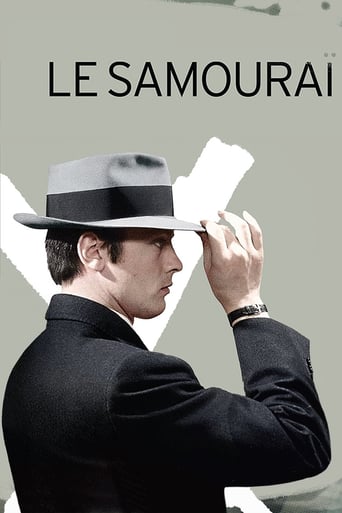
Jean-Pierre Melville was making excellent European crime thrillers long before the emergence of the French New Wave. While French cinema was amid this unparallel wave of innovative cinema, Melville re-invented the noire crime drama with his highly influential movie, “Le Samourai”.
The movie opens in what looks like a dark black and white scene of a sparce bedroom while the credits roll over the screen. Then suddenly I noticed a red spark from a lit cigarette, and I realized that there was a man lying and smoking on the bed. At that point it was also made clear that the movie is in color, rather than black and white. The color however remains dark and muted throughout the film, which essentially transformed Hollywood noire cinema into the world of technicolor.
This is the movie that single handedly transformed the strikingly handsome, Alain Delon, into the cold calculated killer with the golden heart. It will become an image so striking, that Delon would forever be typecast as the silent intelligent man to be reckoned with. He portrays Jef Costello, a hired killer who works independently for whoever will pay his price. Hired by a powerful mob organization to kill a nightclub owner, Costello first builds an airtight alibi with his prostitute girlfriend (Played by Delon’s actual wife Nathalie Delon) and a group of gamblers currently in the middle of an all-night poker binge. At the scene of the killing, he is witnessed by the beautiful nightclub piano player and decides to let her live. Meanwhile the police investigation to the killing is run by a smart and tough superintendent (the excellent Francois Perier), who immediately picks him up as a major suspect. Will the Piano player turn him in, or is her sudden and deep attraction that she has for him enough? This is a question that will leave the people who ordered the killing worried, and soon our anti-hero finds himself being pursued by both the cops and the mob.
Melville films every scene with dark and flushed colors and allows only a minimalist amount of dialogue to carry his story. The result gives off an aura of mystery to the hired killer. There is a bit of Leon’s, man with no name, in Costello. His silent demeanor emotes skill cunning and danger. Delon is wonderful in the role. He was an extremely underrated actor and his ability to invoke these characteristics with only body language and facial expressions is a large part of the extreme charm of the movie. Many actors have tried to imitate Delon’s Costello ever since. Most have not come close to matching the coolness of Alain Delon’s quiet killer. Part of it is the wardrobe with his trench coat, tie, and fedora. Before leaving his apartment, Costello slides his hands across the rim of the fedora, making sure that he looks the part. There is a bit of Costello in the DeNiro and Brando, Don Corleone, of the Godfather movies.
The movie contains a wonderfully detailed surveillance chase through the Paris subway system which depicts how Costello evades countless strategically situated police detectives in the labyrinth of constantly moving trains and emerging tunnels of the Paris Metro system. Suspenseful and fun this is another immensely influential scene that would be immolated on many future urban crime films such as, “The French Connection”. I was never sure if Costello would be able to evade his pursuers and the suspense just added to the fun.
One of the aspects to the movie that I found fascinating was the little details that Melville incorporates in his story. For example, there is one scene where the police place a bugging device in Costello’s room. Filmed in a realistic minimalistic fashion, without dialogue, I watched as the two detectives scan the sparse room, inch by inch, in search of the ideal location for their bugging device. Later in the film Costello searches his room for the bug and I realized why he lived in such an empty, and small room. This was a man who was used to being followed.
“Le Samourai”, is the movie that would forever classify what is expected of a Delon film. It is also the movie that took the old Hollywood black and white films into the new gritty realistic crime genre of the 1970’s and beyond. It is also one hell of an exciting thriller.

